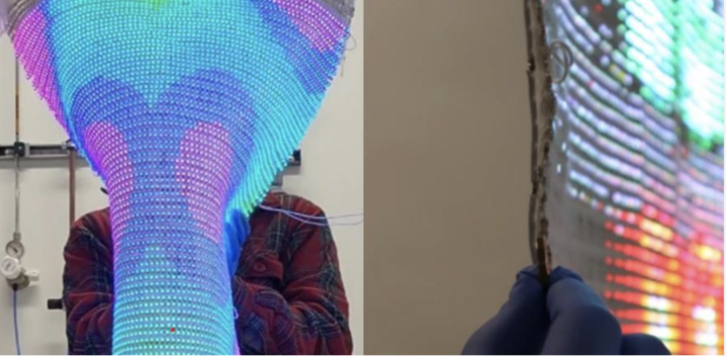
As reported in Nature Communications, an international team of scientists have produced a fully woven smart textile display that integrates active electronic, sensing, energy and photonic functions. The functions are embedded directly into the fibers and yarns, which are manufactured using textile-based industrial processes.
The researchers, led by the University of Cambridge, anticipate applications such as curtains that are also TVs and interactive, self-powered clothing and fabrics.
This is the first time that a scalable large-area complex system has been integrated into textiles using an entirely fiber-based manufacturing approach.
Despite recent progress in the development of smart textiles, manufacturing processes have defined limitations in functionality, dimensions and shapes; previous examples have been little more than interesting swatches. So this is a big potential change.
According the researchers they made technology compatible with weaving by coating each fiber component with materials that can withstand the stretching that occurs on textile manufacturing equipment. The team also braided some of the fiber-based components to improve their reliability and durability. Finally, they connected multiple fibre components together using conductive adhesives and laser welding techniques.
Using these techniques together, they were able to incorporate multiple functionalities into a large piece of woven fabric with standard, scalable textile manufacturing processes, which allows the fabric to be made to scale in large functional rolls.
Remarkably the resulting fabric can serve as a display, monitor inputs, or store energy. The fabric can detect RF signals, touch, light and temperature which suggests possibilities for our industry including distributed sensor networks and interactive displays.
“Our approach is built on the convergence of micro and nanotechnology, advanced displays, sensors, energy and technical textile manufacturing,” said Professor Jong min Kim, from Cambridge’s Department of Engineering, who co-led the research with Dr Luigi Occhipinti and Professor Manish Chhowalla. “This is a step towards the full exploitation of sustainable, convenient e-fibres and e-textiles in daily applications. And it’s only the beginning.”
“By integrating fibre-based electronics, photonic, sensing and energy functionalities, we can achieve a whole new class of smart devices and systems,” said Occhipinti, also from Cambridge’s Department of Engineering. “By unleashing the full potential of textile manufacturing, we could soon see smart and energy-autonomous Internet of Things devices that are seamlessly integrated into everyday objects and many other sector applications.”
The research was funded in part by the European Commission and the Engineering and Physical Sciences Research Council (EPSRC), part of UK Research and Innovation (UKRI).
Reference:
H.W. Choi et al. ‘Smart textile lighting/display system with multifunctional fibre devices for large scale smart home and IoT applications.’ Nature Communications (2022). DOI: 10.1038/s41467-022-28459-6










